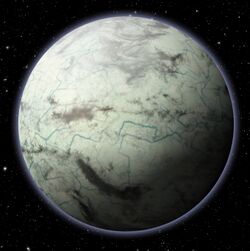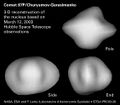Astronomy:Kapteyn b
 Artist's impression of Kapteyn b | |
| Discovery | |
|---|---|
| Discovered by | HARPS |
| Discovery date | June 2014 |
| Radial velocity | |
| Orbital characteristics | |
| 0.168+0.006 −0.008 astronomical unit|AU | |
| Eccentricity | 0.21+0.11 −0.10 |
| Orbital period | 48.616+0.036 −0.032 d |
| Star | Kapteyn's Star |
| Physical characteristics | |
| Mean radius | 1.6+0.41 −0.4 R⊕ |
| Mass | 4.8+0.9 −1.0 M⊕ |
| Mean density | 6.44 g/cm3 |
| Physics | 205 K (−68 °C; −91 °F) |
Kapteyn b is an exoplanet that orbits within the habitable zone of the red subdwarf Kapteyn's Star, located approximately 12.8 light-years (3.92 parsecs) from Earth. Kapteyn b is within the estimated habitable zone of its star.[2] It was the closest-suspected potentially habitable exoplanet to the Solar System other than Tau Ceti e up until 2016, when Proxima Centauri b at 4.22 light-years was confirmed. It was pushed into fourth when Ross 128 b was confirmed in 2017. Later research had cast doubt on the existence of Kapteyn b, suggesting the signal is consistent with stellar activity rather than a planet.[3] This doubt, however, has been refuted by the original discovery team,[4] only to reappear in stronger form in 2021.[5] The system itself is estimated to be 11 billion years old, substantially older than the Solar System.[2]
Characteristics
Mass, radius, and temperature
Kapteyn b is a super-Earth, a planet that has a radius and mass bigger than that of Earth, but smaller than that of the ice giants Uranus and Neptune. It has a surface temperature of 205 K (−68 °C; −91 °F). It has a mass greater than or equal to 4.8 M⊕ and a radius less than or equal to around 1.6 R⊕, depending on its composition, making it a likely rocky world.
Host star
The planet orbits a red subdwarf star named Kapteyn's Star. The star has a mass of 0.27 M☉, a radius of 0.29 R☉ and has about 1.2% of the Sun's luminosity. It has a surface temperature of 3,550 K and is roughly 11 billion years old. In comparison, the Sun is about 4.6 billion years old[6] and has a surface temperature of 5,778 K.[7]
The star's apparent magnitude, or how bright it appears from Earth's perspective, is 8.85. It is too dim to be seen with the naked eye, but can be seen with good binoculars.
Orbit
Kapteyn b makes a complete orbit around its parent star about every 48.62 days at a distance of 0.17 AU (compared to Mercury, which orbits at a distance of around 0.39 AU). It has an eccentricity of 0.21, meaning its orbit is mildly elliptical.
Habitability
The exoplanet was announced to be orbiting in the habitable zone of its parent star, the region where, with the correct conditions and atmospheric properties, liquid water may exist on the surface of the planet. Kapteyn b has a radius range of 1.2–1.6 R⊕, so it is likely rocky. Its host star is a red subdwarf, with a little more than a quarter as much mass than the Sun does. As a result, stars like Kapteyn's Star have the ability to live up to 100–200 billion years, ten to twenty times longer than the Sun will live.[8]
Another crucial factor in habitability is temperature and atmospheric properties. The estimated equilibrium temperature for Kapteyn b is around 205 K (−68 °C; −91 °F), too cold to support liquid water on the surface. Without the proper greenhouse gases in its atmosphere (if it has one), it is likely to be a planet covered in ice. However, if it has enough CO2 in its atmosphere, the surface temperature may rise enough to have water exist in its liquid form on the surface.[original research?]
Discovery
The planet was first discovered by the HARPS spectrometer which is housed at the European Southern Observatory's La Silla Observatory in Chile. Further confirmations of the planetary detection were made at the Keck Observatory in Hawaii and at the PFS Observatory, also in Chile.[2] The method of discovery involved observing and recording tiny wobbles in the star caused by the gravitational tug of its planets, using Doppler spectroscopy.[2]
Additional planet
One other planet has been detected within the same planetary system. It is designated "Kapteyn c" and orbits further out from the star, beyond the outer edge of the habitable zone.[2] It is considered to be too cold for stellar-light-based life.[2]
See also
References
- ↑ Anglada-Escude, G. (8 July 2014). "Two planets around Kapteyn's star: a cold and a temperate super-Earth orbiting the nearest halo red dwarf". Monthly Notices of the Royal Astronomical Society: Letters 443: L89–L93. doi:10.1093/mnrasl/slu076. Bibcode: 2014MNRAS.443L..89A.
- ↑ 2.0 2.1 2.2 2.3 2.4 2.5 2.6 Wall, Mike (3 June 2014). "Found! Oldest Known Alien Planet That Might Support Life". Space.com. http://www.space.com/26115-oldest-habitable-alien-planet-kapteyn-b.html.
- ↑ Robertson, Paul (11 May 2015). "Stellar activity mimics a habitable-zone planet around Kapteyn's star". The Astrophysical Journal 805 (2): L22. doi:10.1088/2041-8205/805/2/L22. Bibcode: 2015ApJ...805L..22R.
- ↑ Anglada-Escudé, G.; Tuomi, M.; Arriagada, P.; Zechmeister, M.; Jenkins, J. S.; Ofir, A.; Dreizler, S.; E. Gerlach et al. (2016). "No Evidence for Activity Correlations in the Radial Velocities of Kapteyn's Star" (in en). The Astrophysical Journal 830 (2): 74. doi:10.3847/0004-637X/830/2/74. ISSN 0004-637X. Bibcode: 2016ApJ...830...74A. http://stacks.iop.org/0004-637X/830/i=2/a=74.
- ↑ A Gaussian Process Regression Reveals No Evidence for Planets Orbiting Kapteyn’s Star
- ↑ Cain, Fraser (16 September 2008). "How Old is the Sun?". Universe Today. http://www.universetoday.com/18237/how-old-is-the-sun/.
- ↑ Cain, Fraser (September 15, 2008). "Temperature of the Sun". Universe Today. http://www.universetoday.com/18092/temperature-of-the-sun/.
- ↑ Adams, Fred C.; Laughlin, Gregory; Graves, Genevieve J. M.. "Red Dwarfs and the End of the Main Sequence". Revista Mexicana de Astronomía y Astrofísica. pp. 46–49. Bibcode: 2004RMxAC..22...46A.
External links
- NASA – Kapteyn b at The NASA Exoplanet Archive.
- Kapteyn's b at The Extrasolar Planets Encyclopaedia from the Paris Observatory
- Kapteyn b in the Habitable Exolanets Catalog at UPR-Arecibo.
Coordinates: ![]() 05h 11m 40.58s, −45° 01′ 06.3″
05h 11m 40.58s, −45° 01′ 06.3″




